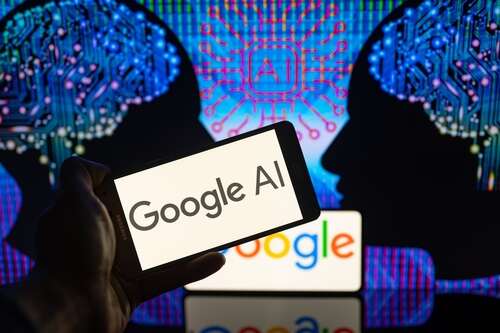
Google is opening up access to its massive 540-billion parameter PaLM (Pathways Language Model) foundation AI model to developers and launching a suite of new features to its own applications using the artificial intelligence tool. As well as opening the API, Google is launching a new tool to allow for rapid prototyping. The company will also add PaLM to its Docs and Gmail applications allowing users to generate content from a simple prompt.

The focus is on opening up generative AI capabilities including introducing the technology to Vertex AI, a machine learning platform created by Google for data science that lets teams collaborate using a single common toolset. The company says bringing PaLM to Vertex will make it easier for data scientists to take advantage of foundation models including allowing businesses to address content generation and chat summarisation use-cases with enterprise-level security.
The move, driven by Google’s cloud division, follows similar announcements from Microsoft around making large foundation AI models available to developers in Azure and through its own toolsets. Access to large language and foundation AI models is becoming a core feature of cloud infrastructure.
Thomas Kurian, CEO of Google Cloud described this as a “pivotal moment” in the company’s AI journey thanks to significant breakthroughs in generative AI that are changing how people interact with technology. He said they have been “responsibly developing large language models so we can safely bring them to our products” rather than rush them out to market. The aim, he wrote in a blog post was to ensure they were ready for market, safe and scalable for developers to start building through Google Cloud.
Google says it is also publishing a generative AI app builder that would make it easier for organisations to utilise the power of PaLM to create chat interfaces and digital assistants similar to ChatGPT, Microsoft’s own Bing Search and the upcoming Google Bard search AI chatbot.
Custom chatbots and tools
“Businesses and governments also want to build their own AI-powered chat interfaces and digital assistants,” wrote Kurian. “To enable this, we are introducing Generative AI App Builder, which connects conversational AI flows with out-of-the-box search experiences and foundation models — helping companies build generative AI applications in minutes or hours.”
This is the first time PaLM has been openly available as part of the Google Cloud AI portfolio through the PaLM API, initially available in the lower size, more-efficient version but the 500-billion-plus model is likely to be added in future. MakerSuite will include prompt engineer and synthetic data generation features with safety tools incorporated, the company explained. The waitlist is due to be published soon.
Kurian says the move adds access to PaLM to previously announced LaMDA APIs. LaMDA is the model that will power Bard and updates to Google Search. “We’re bringing new generative AI capabilities to our Google Cloud AI portfolio to help developers and organisations access enterprise-level safety, security, privacy, as well as integrate with their existing Cloud solutions,” he said.
Google says the Vertex AI platform is already used to develop and deploy ML models and AI applications at scale, but adding PaLM will allow them to generate text and images, then as the technology develops also produce audio and video as needed. “Google Cloud customers will have the ability to discover models, create and modify prompts, fine-tune them with their own data, and deploy applications that use these powerful new technologies,” wrote Kurian.
The company also announced new partnerships to expand the AI ecosystem and bring in other AI-focused software providers and start-ups. Kevin Ichhpurani, corporate VP, global partner ecosystem and channels at Google Cloud said this will include models built by companies like Anthropic and Cohere, as well as generative tools from AI21Labs, Midjourney and Osmo.
“Through our open approach to the AI ecosystem, any partners building foundation models have access to the best of Google Cloud,” Ichhpurani wrote. “The future of artificial intelligence (AI) will be open. New and innovative capabilities in areas like generative AI will come from all corners of the technology ecosystem and from companies distributed around the globe — from early-stage startups to cloud-native AI platforms to large, global enterprises. The momentum in this space is incredible.”
Bringing PaLM to Workspace
As well as making generative AI available as an API for developers to incorporate into their own products, Google announced it would be bringing PaLM to Workspace including Docs and Gmail allowing users to generate responses and copy within the editor. It will also be available for Sheets, Slides, Meet and Chat in future.
There are already some AI features in Workspace including Gmail’s Smart compose and summaries in Docs but to this point, it hasn’t had the full generative capabilities seen in tools like ChatGPT or Wordtune Spices from AI21 Labs. Google says there will be a new set of features that can produce content after typing in a topic. This will generate a draft instantly that can be adapted as needed.
“So if you’re a manager onboarding a new employee, Workspace saves you the time and effort involved in writing that first welcome email. From there, you can elaborate upon or abbreviate the message or adjust the tone to be more playful or professional — all in just a few clicks,” wrote Kurian. These features will be gradually rolled out to a select group of testers in the coming weeks but it isn’t clear when they will be widely available.
This is in part because Google is taking a slow, responsible approach to scaling and rolling out the technology. “We invite external and internal testers to pressure test new experiences,” wrote Kurian. “We have AI principles to guide this work. These principles also serve as an ongoing commitment to our customers who rely on our products to build and grow their business safely.”






